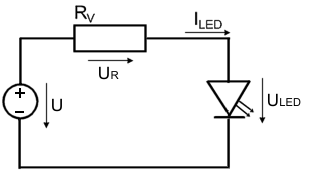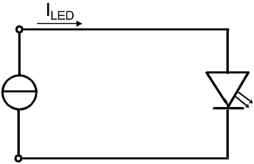Control
There are two common types of control of LEDs: Current-controlled without series resistor and voltage-controlled with a series resistor. Each control method has advantages and disadvantages for certain use cases, which are explained below. Depending on the use case, a decision must be made as to which method of control is to be used.
1. Voltage mode
Voltage mode, e.g. with a battery or a power supply unit, is a simple and cost-effective way of controlling LEDs. All that is needed is an additional series resistor RV. Due to the linear behavior of an ohmic resistance, RV makes the overall circuit much less sensitive to voltage changes, resulting in robust LED control. Due to the ohmic resistance, however, the power loss of the control increases and is given off in the form of heat (PV = RV ⋅ ILED2).
The current ILED through the LED results from the ratio ILED = U/RV.
 Fig.13: Voltage-controlled LED with series resistor
Fig.13: Voltage-controlled LED with series resistorThe series resistor RV is calculated as follows:
RV = UR /ILED
The current through the LED is known. The voltage UR, which is dropped across the series resistor to be calculated, is missing. This voltage is formed from the operating voltage minus the voltage dropped across the LED. The voltage ULED that is dropped across the LED at ILED can be read from the U/I characteristic curve for the LED in the data sheet.
UR = U - ULED
If the brightness of an LED with a series resistor is to be adjusted, the applied voltage must be reduced (darker) or increased (brighter).
However, the disadvantage of this type of control is that the luminous flux cannot be controlled precisely. As described at the beginning, a small change in voltage leads to a big change in current and thus to a big change in the luminous flux. In the case of voltage control, therefore, fluctuations in the supply voltage may have a direct influence on the luminous flux of the LED. It should also be borne in mind that the electrical characteristics of the resistor and the LED are temperature dependent.
- Advantages: simple design, simple control, the brightness of the LED can be set directly via the voltage
- Disadvantages: additional resistance, resulting in waste heat
2. Current mode
An LED can be operated directly if a power source (electronic circuit) is used instead of a voltage source (e.g. battery). With current control, the luminous flux of the LED can be adjusted directly via the specified current value, without resistance. Fluctuations in the supply voltage thus have no influence on the luminous flux of the LED. The luminous flux is constant and reproducible with current control. Current control is thus recommended, for example, in machine vision applications.
 Fig.14: Current-operated LED
Fig.14: Current-operated LED- Advantages: no additional components; the brightness of the LED can be adjusted directly via the current
- Disadvantages: complex power source may be required
 | Glowing LED due to a leakage current Even when the LED is switched off, a small current flow through the LED may occur, depending on the control circuit. Due to this leakage current, the LED glows noticeably in some cases. |
Further information about the control of LEDs with Beckhoff components can also be found in the corresponding Application Note.
https://download.beckhoff.com/download/document/Application_Notes/DK9222-0620-0065.pdf